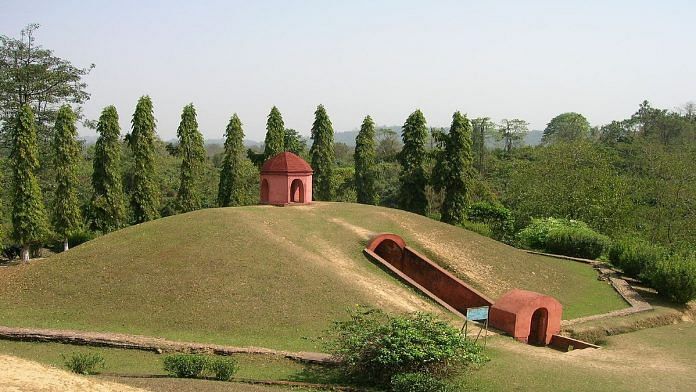New Delhi: Assam’s Charaideo Moidams, or royal burial mounds, are India’s only entry to UNESCO for recognition as a World Heritage site in the cultural category in 2023-24, state Chief Minister Himanta Biswa Sarma announced Saturday.
According to the Assam CM, of 52 tentative sites across the country, pitched by other states, Prime Minister Narendra Modi had chosen Charaideo Moidams as India’s entry. A UNESCO team will visit the site in September and it is expected to be declared a World Heritage site by March next year, Sarma said.
Charaideo Moidams are mounds containing the remains of the royalty of the Ahom dynasty that ruled present-day Assam for 600 years — from the 13th century to the 19th century.
The selection of the Charaideo Moidams as India’s UNESCO World Heritage site entry follows the Bharatiya Janata Party’s (BJP) repeated invocation of the Ahom dynasty.
In 2022, on the 400th anniversary of 17th century Ahom general, Lachit Borphukan, the central government had organised a three-day celebration in Delhi beginning 23 November. During the event, a documentary on the life of Lachit Borphukan, hailed as a Hindu hero, was also launched. The state celebrates 24 November as Lachit Diwas.
What are Moidams?
The Moidams contain the remains of Ahom dynasty royalty. Previously, the Ahoms were buried, but after the 18th century, they adopted the Hindu mode of cremation, and bones and ashes were enclosed in a “moidam” which is an earthen pyramid. These moidams are commonly known as the pyramids of Assam.
“386 Moidams have been explored so far, 90 royal burials at Charaideo are the best preserved, representative, and most complete examples of this tradition,” Sarma said in a letter to the PM on 16 January.
Charaideo, or the “shining town on a hill top”, was the first capital established by King Chaolung Sukapha, the founder of the dynasty, in 1229 CE. Through the 600 years of the Ahom rule, the capital was shifted several times. Yet, Charaideo remained the symbolic centre of power.
Who were the Ahoms?
The Ahoms reportedly represented a time when the “Assamese race was united and able to fight an alien, formidable force such as the Mughals”. “The British reduced a brave race to an abject state…Even in free India, we had to fight for everything,” Arup Kumar Dutta, author of the book The Ahoms has been quoted as saying in the media.
The Ahoms, who were non-Hindus, adopted the local religion, Hinduism, during the reign of Sudangpha (1397-1407). “It was the first time that Hinduism, which was the predominant religion outside the Ahom realm, penetrated into it right at the very top. Hindu rituals, including worship of Laxmi-Narayan Shaligram in addition to the Shan idol Somdeo, began to be performed at the royal palace. Later, the Hindu God Indra supplanted Lengdon (the ruler of heaven) in Ahom and Ahom kings began to adopt Hindu names in addition to the Shan titles,” Dutta wrote in the book.
Ahoms in current day politics
In the run-up to the 2021 assembly polls in Assam, Ahoms took centrestage in the BJP’s campaign with Borphukan, Assam’s “greatest military hero”, as its face.
Borphukan was a commander in the Ahom kingdom and was known for his leadership in the 1671 battle of Saraighat that foiled an attempt by the Mughal forces to capture Assam.
Last year, on the occasion of Borphukan’s 400th birth anniversary, PM Modi tweeted “Greetings on Lachit Diwas. This Lachit Diwas is special because we mark the 400th birth anniversary of the great Lachit Borphukan. He epitomised unparalleled courage. He placed the well-being of people above everything else and was a just as well as visionary leader”.
We bow to the valorous Lachit Borphukan on his 400th birth anniversary. He played pivotal role in preserving the culture of Assam. https://t.co/w8eG6BAGby
— Narendra Modi (@narendramodi) November 25, 2022
In March 2021, PM Modi even referred to Borphukan as a freedom fighter, saying that he “contributed to Independence”.
The general had died nearly 200 years before the freedom movement.
(Edited by Smriti Sinha)
Also read: Romila Thapar takes on camps of history, heroin addicts and storytellers



